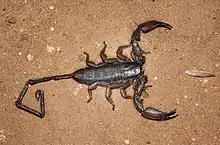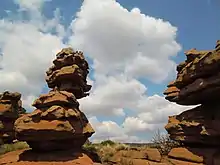| Hadogenes troglodytes | |
|---|---|
 | |
| Scientific classification | |
| Domain: | Eukaryota |
| Kingdom: | Animalia |
| Phylum: | Arthropoda |
| Subphylum: | Chelicerata |
| Class: | Arachnida |
| Order: | Scorpiones |
| Family: | Hemiscorpiidae |
| Genus: | Hadogenes |
| Species: | H. troglodytes |
| Binomial name | |
| Hadogenes troglodytes (Peters, 1861) | |
Hadogenes troglodytes is a species of scorpion from southern Africa. It is commonly known as the flat rock scorpion and commonly sold on the exotic pet market.[1][2] It was once regarded as having the longest recorded body length of any scorpion, reaching up to 20 cm;[3] however Heterometrus swammerdami currently holds the record for being the world's largest scorpion at 9 inches (23 cm) in length.[4] May be confused with Hadogenes bicolor.
Distribution
It is known from the Limpopo province, reaching the northern parts of the Mpumalanga provinces. It occurs up into Botswana, Zimbabwe, and western Mozambique.
Description
The overall body appearance is consistent with other members of Hadogenes. The carapace, pedipalps, chela, sternites, and metasoma are all flattened allowing them to maneuver in and out of the small cracks and crevices that are abundant in the rocky outcrops they are endemic to.
Characterized by highly specialized curved telotarsal claws which allows then to move quickly within their environment, but hinders their locomotion on looser substratum such as sand.[5]
The carapace, pedipalps, and metasoma are all black while the legs and chela are pale to yellow. The metasoma and stinger are comparatively small when contrasted against other similarly sized scorpion species.
Habitat

Troglodytes thrives in a slightly humid rocky environment. The ideal troglodytes habitat has plenty of cracks and crevices available. This species remains highly localized tending to moving up and down one rocky outcrop for their entire lives. Troglodytes is unable to travel for extended periods of time across the sand and will die of exposure. Troglodytes is threatened by habitat loss due to mining.[6]
Behavior
Troglodytes is very reclusive and is likely to remain unseen unless their hiding place is disturbed. This species of scorpion will generally sting as a last defense and will try to flee before fighting. Nocturnal hunter, preferring to leave its hiding spots when it is cooler, predates on insects up to its own body size.[7]
This species is quite adapt at burrowing and can quickly excavate the soil and gravel from beneath a stone ledge to create a new den. A troglodytes will use its tail to assist in its burrowing by using it to sweep the dirt away.
Highly territorial and will fight to the death with other members of its species when kept in close captivity together. Species demonstrates cannibalism.
Venom
Very mild venom, pain lasting only several minutes. LD50 values are reported between 1800 and 2667 mg/kg. May prove medically valuable for use on ion channel-associated diseases and infections caused by antibiotic-resistant pathogens. Demonstrating 121 novel venom peptides under transcriptomic analysis.[8]
See also
References
- ↑ Stephen W. Bullington (1996). "7 No. 5". Natural History and Captive Care of the Flat Rock Scorpion, Hadogenes troglodytes. The Vivarium Magazine. pp. 18–21.
- ↑ Chiariello, Thiago M. (2017-04-01). "Veterinary Care of Scorpions". Journal of Exotic Pet Medicine. 26 (2): 114–122. doi:10.1053/j.jepm.2017.01.030. ISSN 1557-5063.
- ↑ Fred Punzo (2000). "Scorpions (Scorpiones)". Desert arthropods: life history variations. Springer. pp. 128–138. ISBN 978-3-540-66041-5.
- ↑ Manny Rubio (2000). "Commonly Available Scorpions". Scorpions: Everything About Purchase, Care, Feeding, and Housing. Barron's. pp. 26–27. ISBN 978-0-7641-1224-9.
The Guinness Book of Records claims [...] Heterometrus swammerdami, to be the largest scorpion in the world [9 inches (23 cm)].
- ↑ PRENDINI, LORENZO (2006). "New South African Flat Rock Scorpions (Liochelidae: Hadogenes)". American Museum Novitates (3502): 1. doi:10.1206/0003-0082(2006)502[0001:nsafrs]2.0.co;2. ISSN 0003-0082. S2CID 85862835.
- ↑ Cook, Robert B. (2020-06-10). "Minerals and Gemstones of East Africa by Bruce Cairncross. Strunk Nature–Penguin Random House of South Africa; www.penguinrandomhouse.co.za. 144 pages; 2019; R250 (softbound)". Rocks & Minerals. 95 (4): 381. doi:10.1080/00357529.2020.1759357. ISSN 0035-7529. S2CID 221061858.
- ↑ Leeming, Jonathan (2019). Scorpions of Southern Africa (2nd ed.). Cape Town, South Africa. ISBN 978-1-77584-652-9. OCLC 1090768587.
{{cite book}}: CS1 maint: location missing publisher (link) - ↑ Zhong, Jie; Zeng, Xian-Chun; Zeng, Xin; Nie, Yao; Zhang, Lei; Wu, Shifen; Bao, Aorigele (2017-01-06). "Transcriptomic analysis of the venom glands from the scorpion Hadogenes troglodytes revealed unique and extremely high diversity of the venom peptides". Journal of Proteomics. 150: 40–62. doi:10.1016/j.jprot.2016.08.004. ISSN 1874-3919. PMID 27519694.